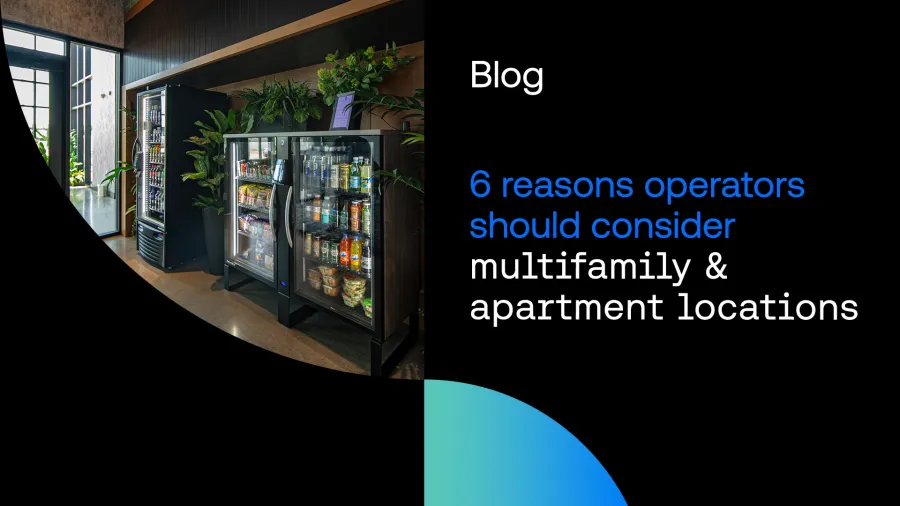Published • 16 Sep 2025
Every operator knows the frustration of investing in a site and waiting to see if traffic shows up. Offices can lose tenants, schools can shift contracts, and a high-potential location can turn slow overnight. Apartments flip that script. The traffic is already there, day in and day out, with hundreds of residents living just steps from where a cooler or market could sit. They have spending power, repeat needs, and no reason to leave the building if a solution is offered inside.
That’s the real story of multifamily: not chasing customers, but serving them where they already live. Here’s why operators should take a closer look.
1. Built-in, Repeat Foot Traffic
In most locations, the hardest part is getting people through the door. But with multifamily, the “customer base” lives upstairs. That creates reliable foot traffic you don’t need to advertise for, and it doesn’t rely on walk-in visibility or neighborhood competition.
For operators, this lowers acquisition cost. You’re not funding promotions or discounts just to get people in front of your store. Instead, focus on placement: place coolers in high-traffic areas, such as mailrooms, lobbies, or near package lockers. When residents pass by two or three times a day, your store naturally stays top-of-mind.
2. Predictable Demand Patterns
Office demand dries up after 5 p.m. School demand disappears in the summer. Apartment demand doesn’t stop—it simply shifts throughout the day. Morning sales tend to favor coffee, energy drinks, and grab-and-go breakfast options. Evenings lean heavily on beverages, snacks, and meal solutions. Late night brings “I ran out” essentials like paper towels, trash bags, or bottled water.
This consistency makes forecasting easier. Instead of gambling on variable foot traffic, operators can stock with confidence, reduce spoilage, and tighten delivery schedules. Predictable demand also makes it easier to test promotions or loyalty programs, since shopper behavior repeats week after week.
3. Four Dayparts Without Extra Labor
The strength of multifamily lies in its coverage. A smart cooler or market in a multifamily building isn’t tied to a 9-to-5 flow of people like an office is. It’s live 24 hours a day, seven days a week. That means one unit covers four natural dayparts—morning, midday, evening, and late night—without requiring additional staff or service hours.
The same piece of equipment generates revenue across multiple shopping missions. That stretches ROI and makes every square foot work harder. And because the shopper base is consistent, the assortment can be fine-tuned to maximize productivity at each daypart, whether that’s cold brew in the morning or microwavable meals after work.
4. Route Density You Can Scale
Operators know the pain of zig-zagging across a city to service scattered accounts. Multifamily solves that by clustering. Property management companies rarely have just one building—they often control 5, 10, or even 20 properties within a region.
One successful install can snowball into a portfolio deal, where multiple properties come online at once. That turns routing into a simple loop instead of a patchwork. Less windshield time, fewer trips back to the warehouse, and more sales per stop all translate to healthier margins.
5. Amenity Value That Property Managers Champion
Property managers care about resident renewals, online reviews, and lease competitiveness. A market or smart cooler isn’t just a convenience; it’s an amenity they can showcase. For them, it adds value to the property without requiring staff effort.
This dynamic creates partnership potential. Managers are more likely to promote your store in resident communications, support you with prime placement, and even refer you across their portfolio. For operators, that advocacy reduces friction, builds goodwill, and creates paths to expansion; you don’t get bogged down in more transactional channels.
6. Strong Fit for Loyalty
Apartments bring back the same shoppers over and over, making them an ideal environment for loyalty programs. Instead of anonymous, one-time purchases, you’re building habits with a closed group of residents.
Loyalty points, app-based credits, or tiered rewards are more effective here because residents can earn and redeem them quickly. That feedback loop increases frequency, lifts basket size, and makes shoppers less likely to default to delivery apps. For operators, it’s a long-term play that compounds value and keeps revenue stable.
The Bottom Line
Apartments take the uncertainty out of traffic and replace it with repeatable sales. With guaranteed foot flow, steady demand patterns, round-the-clock shopping, portfolio growth potential, property manager advocacy, and loyalty that actually sticks, multifamily buildings offer operators a dependable and scalable channel.
How 365 Retail Markets Helps
365 Retail Markets provides the technology and support to make multifamily markets and smart stores profitable from day one. With self-checkout kiosks, computer vision coolers, loyalty solutions, and real-time analytics, we provide operators with the tools to manage residential accounts with confidence.
If you’re ready to break into apartments and multifamily buildings, contact 365 Retail Markets today. We’ll help you evaluate your opportunities, choose the right format, and build a strategy that pays back quickly.

